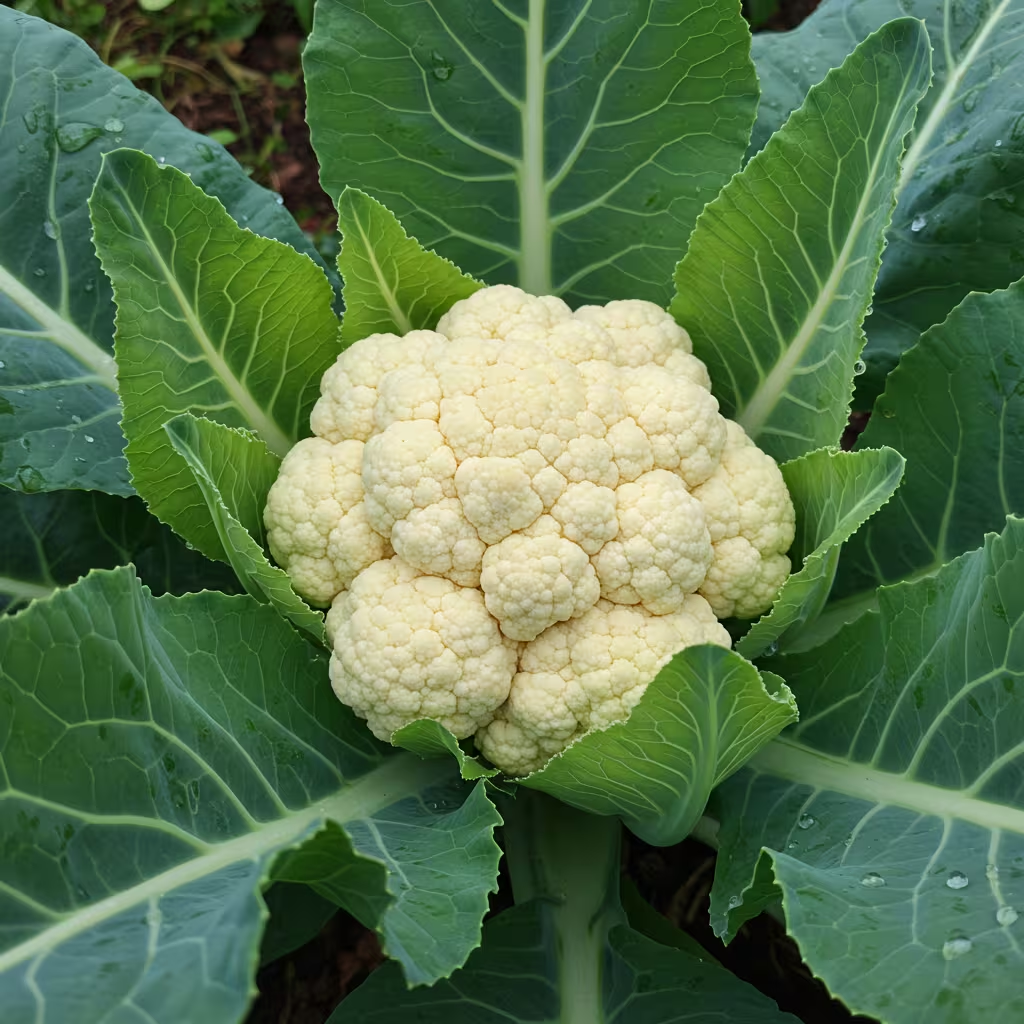Growing cauliflower at home can be incredibly rewarding, despite its reputation as one of the more challenging vegetables in the brassica family. With proper timing, consistent care, and an understanding of this unique vegetable’s growth cycle, you can harvest picture-perfect heads that surpass anything you’ll find in grocery stores. This comprehensive guide will walk you through every step of the cauliflower-growing process, from selecting the right varieties to knowing exactly when to harvest.
Understanding Cauliflower: The Challenging yet Rewarding Brassica
Cauliflower (Brassica oleracea var. botrytis) stands out even among its brassica relatives. While related to broccoli, cabbage, and kale, cauliflower requires more attentive care to produce those dense, flavorful heads. The extra effort pays off with a versatile vegetable that can be transformed into everything from traditional side dishes to pizza crusts and grain-free “rice.”
Unlike its more forgiving cousins, cauliflower is sensitive to temperature fluctuations and requires consistent moisture throughout its growth cycle. This sensitivity is why many gardeners consider it the “diva” of the vegetable garden—but also why successfully growing it brings such satisfaction.
Selecting the Perfect Cauliflower Variety for Your Garden
The first step toward cauliflower success begins with choosing the right variety for your growing conditions:
Classic White Varieties
- ‘Snowball’: An heirloom variety with dependable 6-7 inch heads, matures in approximately 70-80 days
- ‘Amazing’: Known for heat tolerance and resistance to browning, produces dense 7-8 inch heads
- ‘Snow Crown’: An award-winning hybrid that’s more forgiving for beginners, ready in 50-60 days
Colorful Alternatives
- ‘Purple Cape’: Stunning purple heads that turn green when cooked, with a milder flavor
- ‘Cheddar’: Vibrant orange heads packed with additional beta-carotene
- ‘Veronica’: A striking lime-green Romanesco type with mesmerizing fractal patterns
When selecting your variety, consider your local climate and growing season. Spring-planted cauliflower requires varieties that can withstand occasional warm spells, while fall crops need varieties that can handle light frosts. Always check seed packets for “days to maturity” to ensure your plants will have enough time to develop before extreme temperatures arrive.
Timing Is Everything: When to Plant Cauliflower
Cauliflower performs best in temperatures between 60°F and 70°F (15°C to 21°C). Outside this range, plants may experience stress that leads to small heads or premature flowering.
Spring Planting
Start seeds indoors 4-6 weeks before your last expected spring frost. Transplant seedlings outdoors when they have developed 4-6 true leaves and nighttime temperatures consistently stay above 40°F (4°C).
Fall Planting (Recommended for Beginners)
For a fall crop, calculate your planting date by counting backward from your first expected fall frost. Add the days to maturity (from the seed packet) plus an additional 14 days to account for slower fall growth. Start seeds accordingly, typically in mid-summer.
Many experienced gardeners prefer fall cauliflower crops because the gradually cooling temperatures tend to produce sweeter, more tender heads with fewer pest problems.
Creating the Optimal Growing Environment
Soil Preparation
Cauliflower demands nutrient-rich soil with excellent drainage:
- Work 2-3 inches of compost or well-rotted manure into your garden bed
- Aim for a pH between 6.0 and 7.0 (slightly acidic to neutral)
- Consider a soil test to identify any specific deficiencies
- Add lime if your soil is too acidic, or sulfur if it’s too alkaline
Planting Techniques
Whether transplanting seedlings or purchasing starts from a nursery:
- Space plants 18-24 inches apart in rows 2-3 feet apart
- Plant seedlings slightly deeper than they were in their containers
- Water thoroughly immediately after planting
- Apply a 2-3 inch layer of organic mulch around plants (but not touching stems)
Essential Care for Thriving Cauliflower Plants
Watering Requirements
Consistent moisture is non-negotiable for quality cauliflower:
- Provide 1-1.5 inches of water weekly through rainfall or irrigation
- Use drip irrigation or soaker hoses to keep foliage dry
- Never allow the soil to dry out completely between waterings
- Increase watering during head formation if conditions are dry
Fertilization Strategy
Cauliflower’s heavy feeding needs require a thoughtful approach:
- Apply a balanced fertilizer (10-10-10) 3-4 weeks after transplanting
- Side-dress again when heads begin to form
- Consider supplementing with fish emulsion or compost tea every 2-3 weeks
- Avoid excessive nitrogen, which promotes leafy growth at the expense of head development
Temperature Management
Help your cauliflower cope with temperature challenges:
- Provide afternoon shade in warm weather using shade cloth
- Use row covers to protect from unexpected late frosts
- Plant heat-tolerant varieties if your spring tends to warm quickly
- Use mulch to moderate soil temperature fluctuations
The Art of Blanching Cauliflower
Blanching is a unique technique specific to cauliflower cultivation that protects developing heads from sunlight:
Why Blanch?
- Prevents heads from turning yellow or green
- Produces whiter, more tender curds
- Reduces bitterness that can develop with sun exposure
How to Blanch Traditional Varieties:
- When heads reach 2-3 inches in diameter, gently pull outer leaves over the developing head
- Secure with soft twine, rubber bands, or clothes pins
- Ensure some air circulation to prevent rot
- Check underneath every few days to monitor growth and prevent pests
Self-Blanching Varieties
Many modern hybrids have been bred with leaves that naturally curl over the developing head:
- ‘Snowball Y’ and ‘Snowball Self-Blanching’ have this convenient trait
- Colored varieties (purple, orange, green) don’t require blanching
- Self-blanching types are ideal for beginner gardeners
Managing Pests and Diseases
Cauliflower faces challenges from various insects and pathogens:
Common Pests
- Cabbage worms: Handpick or use Bacillus thuringiensis (Bt)
- Aphids: Spray with insecticidal soap or a strong stream of water
- Flea beetles: Apply diatomaceous earth around young plants
- Root maggots: Use protective collars at the base of plants
Disease Prevention
- Practice crop rotation (avoid planting brassicas in the same spot for 3-4 years)
- Ensure proper plant spacing for good air circulation
- Water at the base of plants rather than overhead
- Remove and destroy any diseased plant material immediately
Harvesting at the Perfect Moment
Knowing when to harvest is crucial for quality cauliflower:
Harvest Indicators
- Heads should be firm and compact
- Optimal size is 6-8 inches in diameter
- Curds should be tight with no separation
- Cut while heads are still slightly immature rather than waiting too long
Harvesting Technique
- Use a sharp knife to cut the stem about 1-2 inches below the head
- Keep a few wrapper leaves attached to protect the head
- Harvest in the morning when temperatures are cool for best flavor
- Cut at an angle to prevent water collection on the remaining stem
Common Harvesting Issues
- Buttoning: Small, premature heads caused by stress or temperature fluctuations
- Riciness: Heads with a grainy texture, typically from harvesting too late
- Bolting: Plants going to seed before forming proper heads, usually due to heat stress
Enjoying Your Cauliflower Harvest
Storage Options
- Fresh cauliflower keeps 1-2 weeks in the refrigerator when wrapped in a damp paper towel and placed in a perforated plastic bag
- For longer storage, blanch florets for 2 minutes, cool quickly in ice water, and freeze
- Pickled cauliflower can be preserved for months
Beyond Basic Preparation
- Roast with olive oil and garlic for a caramelized flavor
- Pulse raw florets in a food processor to create cauliflower “rice”
- Mash cooked cauliflower as a lower-carb alternative to potatoes
- Use as a pizza crust base for grain-free options
Troubleshooting Common Cauliflower Growing Problems
Loose or “Ricy” Heads
- Cause: Temperature fluctuations, especially heat spikes
- Solution: Choose heat-tolerant varieties and provide afternoon shade
Brown Spots on Heads
- Cause: Boron deficiency in soil
- Solution: Apply a balanced fertilizer or specific micronutrient supplement
Failure to Form Heads
- Cause: Improper timing, heat stress, or nutrient deficiencies
- Solution: Plan planting dates carefully and ensure consistent feeding
Conclusion: The Rewarding Challenge of Homegrown Cauliflower
Growing cauliflower demands attention to detail and patience, but the rewards are substantial. Nothing compares to the satisfaction of harvesting a perfectly formed head of cauliflower that you’ve nurtured from seed to table. The flavor and texture of homegrown cauliflower far exceed store-bought options, and the variety of colors and types available to home gardeners offers exciting culinary possibilities beyond the standard white heads found in supermarkets.
By following the guidelines in this comprehensive guide, even gardeners who have struggled with cauliflower in the past can achieve excellent results. Remember that each growing season brings new knowledge, and even experienced gardeners continue to refine their cauliflower-growing techniques year after year.
Whether you’re growing classic white varieties or experimenting with purple, orange, or Romanesco types, the principles remain the same: provide rich soil, consistent moisture, appropriate temperatures, and vigilant care. Your efforts will be rewarded with one of the garden’s most impressive achievements—a perfect head of homegrown cauliflower.

